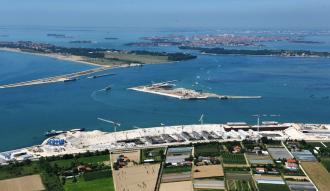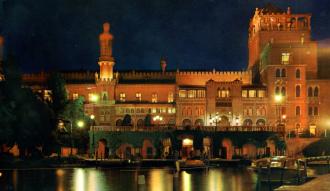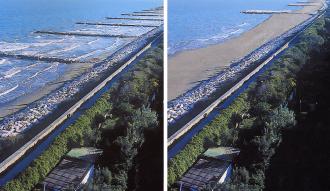The Lido
The Lido of Venice (also simply called ‘the Lido’) is a thin island stretching for about 11 km between the Venetian Lagoon and the Adriatic Sea, with the San Nicolò inlet at its northern end and the inlet of Malamocco at its southern end. The only way to arrive from the mainland is by water: boats and waterbuses and ferries for the transport of vehicles (the Lido is one of the few islands of the lagoon with asphalt roads and cars). The Lido also has a small tourist airport.
There are three settlements on the island: The Lido, Malamocco and Alberoni. The Lido itself, in the north, is today mainly a residential area and the main beach area of Venice, but in the early 1900s it was the destination of the international jet set. Malamocco, in the centre, was the first settlement and was once home to the Doge of Venice; Alberoni, at the southern end, is home to the 18-hole golf course created in the 1930s.
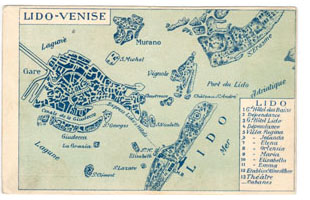 The second half of the 19th century saw the Lido – known as the Golden Island due to its 6 km of beaches – become a seaside resort with the establishment of the Società Civile Bagni Lido in 1872 and, a few years later, with the construction of the hotels Excelsior and Des Bains, and the Casino. In 1932 it became the centre of the Venice Film Festival, now one of the most important events in the international film scene.
The second half of the 19th century saw the Lido – known as the Golden Island due to its 6 km of beaches – become a seaside resort with the establishment of the Società Civile Bagni Lido in 1872 and, a few years later, with the construction of the hotels Excelsior and Des Bains, and the Casino. In 1932 it became the centre of the Venice Film Festival, now one of the most important events in the international film scene.
Today, the Lido is a large residential suburb of Venice that has kept its character and role as a seaside resort for Venice. With limited connections to the city, the Lido has been unable to adapt itself to the requirements of mass tourism or to offer a diverse range of job possibilities.
The Lido is currently undergoing major redevelopment work carried out by a private developer, EstCapital. The work includes the restructuring and conversion of the Hotel Des Bains to a luxury residential resort (58 residences in the main building and 4 villas located in the park). The completion and delivery of the residences are expected by spring 2013.
The project also includes the restoration of the Hotel Excelsior, the creation of a residential and tourist resort at the former Hospital (Ospedale al Mare) and the creation of a dock near the inlet to Venice, which will be able to accommodate about 1,000 berths in an area equipped to accommodate large yachts and that can provide modern port and non-port services.
It is vital, therefore, to activate a systemic regeneration of the area based on territorial integration capable of triggering processes of socio-economic development with the aim of improving the quality of life of its citizens, restoring its identity and increasing the attractiveness of the Lido.
The physical interventions – the MOSE Project
The Lido island – together with the system of smaller islands including La Certosa and Pellestrina – acts as a physical barrier protecting the Venetian Lagoon from the tides of the Adriatic Sea. The Lagoon is connected to the Adriatic sea through 3 inlets: Lido, Malamocco and Chioggia and the city of Venice has always been affected by frequent floods (known as acqua alta, high water). After almost 20 years of research and the evaluation of numerous possible solutions, the MOSE project (Modulo Sperimentale Elettromeccanico) was created to defend the inhabited areas of the lagoon from high tides.
Started in May 2003, the MOSE project is an experimental model for evaluating the performance of a mobile barrier; the idea is to lay a series of 79 flap-gates in the sea bed at the three entrances to the lagoon.
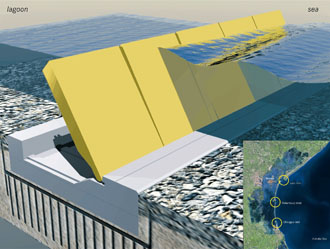 When tides are predicted to rise above 110 centimetres, the gates (20m-wide metal box-like structures normally filled with water) will be filled with air causing them to rise on their hinges and block the incoming water from the Adriatic Sea. In this way it will be possible to temporarily isolate the lagoon from the sea thus blocking the flow of the tide. The inlets remain closed for the duration of the high water and for the time it takes to manoeuvre the flap-gates (in total an average of 4.5 hours). Water quality, safeguarding of the morphology and landscape, and port activities are thus guaranteed. This engineering work is due to be completed by 2014.
When tides are predicted to rise above 110 centimetres, the gates (20m-wide metal box-like structures normally filled with water) will be filled with air causing them to rise on their hinges and block the incoming water from the Adriatic Sea. In this way it will be possible to temporarily isolate the lagoon from the sea thus blocking the flow of the tide. The inlets remain closed for the duration of the high water and for the time it takes to manoeuvre the flap-gates (in total an average of 4.5 hours). Water quality, safeguarding of the morphology and landscape, and port activities are thus guaranteed. This engineering work is due to be completed by 2014.
The Island of La Certosa – Vento di Venezia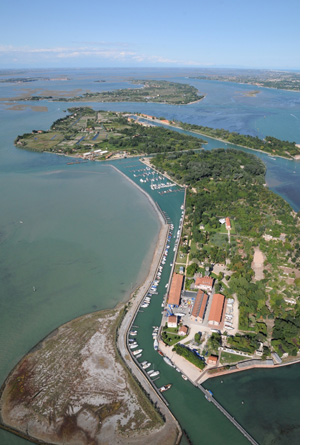 La Certosa is one of the largest islands in the Venetian Lagoon; its geographical position makes it part of the city center. In 2005, by virtue of an agreement with the Municipality of Venice, the island of La Certosa, used in the past as a military firing range, became a centre for boating developed by Vento di Venezia (VDV). VDV Srl is a company founded in 2003 with the aim of designing, building and operating facilities and services for recreational boating in the venetian Lagoon and for the physical and socio-economic rehabilitation of degraded areas.
La Certosa is one of the largest islands in the Venetian Lagoon; its geographical position makes it part of the city center. In 2005, by virtue of an agreement with the Municipality of Venice, the island of La Certosa, used in the past as a military firing range, became a centre for boating developed by Vento di Venezia (VDV). VDV Srl is a company founded in 2003 with the aim of designing, building and operating facilities and services for recreational boating in the venetian Lagoon and for the physical and socio-economic rehabilitation of degraded areas.
At the Polo Nautico, Vento di Venezia is operating a boatyard for the construction and maintenance of traditional Venetian boats; it also provides technical facilities for pleasure craft of all kinds, water sports training and a sailing school. Spaces around the island are used as mooring facilities for boats and yachts. In 2007 Vento di Venezia opened a hotel with a bar and restaurant serving the island. VDV also hosts postgraduate education activities with particular attention paid to yachting. With the goal of recovering the entire island of La Certosa, VDV Srl has worked on a feasibility study for the redevelopment of the heritage buildings (46) and open spaces of the island (the creation of an urban park) as well as the development of vineyards and orchards, winning the tender for the management of the entire compendium for fifty years through a public-private partnership. The intervention, divided into functional areas in early 2011, will run until 2015.
Topics to be developed during the project:
- physical defence;
- urban regeneration;
- functional recovery;
- economic development.

